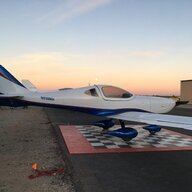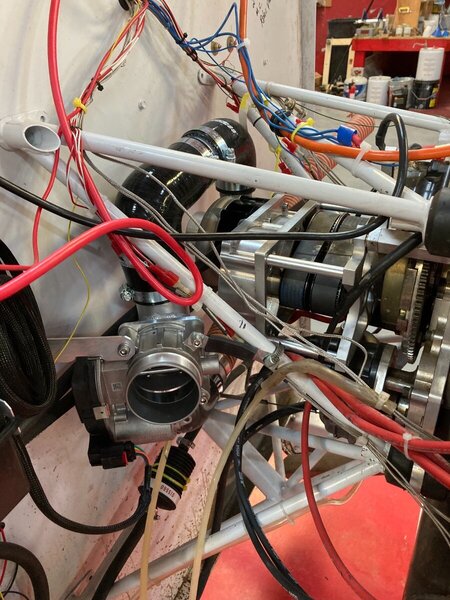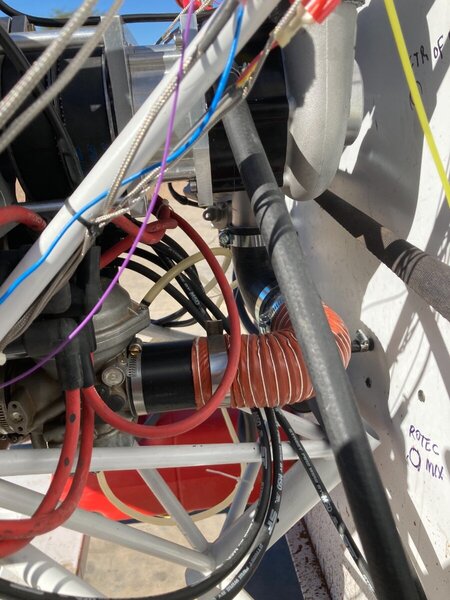-
Posts
41 -
Joined
-
Last visited
About Mhalc
- Birthday 01/01/1957
Information
-
Aircraft
ALIG
-
Location
USA
-
Country
USA
Recent Profile Visitors
The recent visitors block is disabled and is not being shown to other users.
Mhalc's Achievements

Active member (2/3)
-
I thought I would post some updates to my supercharger project. I have changed the drive section from a 2 x 25mm pulley/belt system to a single 50mm pulley/belt system. Much easier assembly and maintenance, so far much more reliable. The test flights have been at altitudes between 8000’-10000’ (DA) at 2900-3000 RPM. With the boost controller set to provide 32 - 36 inHg MAP. In this range my Lightning is cruising at 178 mph (up from 147). Increasing the boost above 36 inHg does produce more (HP) and speed but the speed increment is smaller for each increase above 36 inHg. (Still noodling on that one). BTW the CHT/Oil temps have increased slightly on my gen4, but well within the green. If interested more details can be viewed at: <N530mh.tumblr.com>
-
The first 2 test flights of a supercharged Jabiru 3300 (Gen4) are complete. Still several issues to work thru but in general the overall performance is working out to be with in 5% of the design targets. With modest boost levels (32 inHg) @ 5000’ DA my Lightning cruised at 171 mph (up from 145 mph). The fuel consumption increased ~ 1 gph, which is consistent with its normal 25 mpg running normally aspirated. In addition the takeoff run and climb performance improved by ~20%. These are very preliminary numbers and more test flights will zero in on the final performance levels. The next series of tests will be conducted with higher fuel pressures, allowing higher boost levels. I plan to limit the total boost levels to 36 inHg which should yield 180-187 mph between 5,000’ and 12,000’ DA. https://newtube.app/user/N530MH/91LQNga
-
That would be true where if the supercharged engine was operated as a “normalizer” where boost pressure was regulated to 30 inHg (which is an option for this system). Otherwise boosting an engine increases its effective CR which develops higher BMEP/IMEP, hence the concern for piston/wrist pin wear. Yes, heat is a concern. As for my gen4 3300, the first 150 hrs have demonstrated its ability to run cool and shed heat nicely. Burning more fuel generating more power will surely increase the heat as will the compressors inlet air temp. With the TBI and Jabiru’s fixed timing the only protection I have against “knock” is the boost controllers monitoring of the inlet air temp’s and reducing/eliminating boost if I get any where near the knock limit. In addition I only use 100LL fuel which will also help control “knock”. For simplicity and based on ground testing only, I have not install an intercooler but have provisions for installing one if needed. I know I am leaving some HP (and increasing heat) on the table by not installing one now, so I’ll see how flight testing goes.
-
The goal here is not gobs of HP, but altitude performance. Keeping a modest HP increase (14%-20% at SL) through a wide altitude range. In my case I routinely fly between 9,000’-13,000’ DA. The modest HP increase and critical altitude of ~16,000’ DA I hope to see a 25-30kts increase in cruse speed (flight tests this month will tell!).
-
The test stand engine is an early Gen2 and I monitored through bolt and head bolt torque for the duration of the ground testing. Neither exhibited any change during the test cycle. BMEP increased by ~18% at the tested boost levels, I am more concerned with piston/wrist pin wear. I expect the overall life expectancy will be reduced (as with any performance modification) and plan top end inspections as I transition from flight test to general use. I’ll need to accumulate some real world hours before I really know the impact. To answer your specific question, I did not calculate force caused by an increased BMEP/IMEP as it translates from the crank->cases->through bolts. But was and will be monitored during the remaining test phases.
-
I have completed testing on the test stand of a supercharged Jabiru 3300. The tests were conducted with a Bing 94/40 carburetor and Rotec mkII 40mm TBI. With a modified fuel system the Bing operated well with manifold pressures to 36 inHg generating ~137HP. With the TBI the engine operated well with manifold pressures to 38 inHg. I have started installation on my aircraft (Gen4 3300, with new pistons as part of a Jabiru recall). Ground testing should start in a week or so, and when all checked out, flight testing. Short term goals are to identify practical operating manifold pressures (target is 40” MAP takeoff power and 34-38” cruise), validate boost control computer software (SL thru 16,000’ DA), and aircraft performance. A short video of the last ground test with the boost control computer configured for boost pressures of 3psi/36”MAP https://newtube.app/N530MH/qZqXzbc
-
There is not a separate backfire relief valve. The design is “draw-thru” so the Blow-Off-Valve (BOV) vents the boost overboard unlike a “blow-thru” which would have a fuel/air mixture and needs to be recirculated before the blower to prevent compressor stalls during rapid deceleration. In addition the BOV remains open until takeoff/climb/cruise power settings are selected.
-
So far the test stand testing is progressing well. The current configuration is an old Jabiru 3300 (SN 966) and Bing 94/40 carburetor. The supercharger is ROTREX C15-60 with a custom drive/mount assembly with a electrically controllable BOV to regulate the boost level. Current boosted output is in the 140HP range, which will be available thru ~10,000DA and 120HP thru ~16,000’DA. The next series of tests will be with the Rotec 40mm TBI, followed by ground and flight testing in a Jabiru powered (Gen4 3300) Lightning. https://newtube.app/user/N530MH/tbt4GD6
-
Yes the TBI has traditional mixture control and less sensitive to fuel pressure. In the stock configuration, I have been using a HACman for mixture control with the Bing. I fly regularly between 8,500’ and 12,500’ and the HACman performed well. Still need to test the HACman in the supercharged configuration.
-
For my application (Gen4 3300) I have a 40mm TBI, but I have been approached for Gen2/Gen3 options as well. So I have been working out suitable fuel systems for the Bing. For the Bing, you need a higher pressure fuel pump, and boost referenced pressure regulator. As the float needs (4psi + boost pressure) fuel pressure to operate. Your are correct it has taken longer than I expected to get here, but I am starting to get good results and integration is progressing well. I hope to have test flights in and fly to Sun-N-Fun this year.
-
I have completed the first series of ground tests (test stand) of a supercharged 3300. These tests were conducted using a Bing carby, at manifold pressures to 34”MAP (just slightly higher than a normalized engine). Future tests (after the first of the year) will be used to identify a practical maximum for the Bing (which may turnout to be 34”MAP). Followed by a series of tests using the Rotec 40mm TBI, with the expectations the TBI will handle higher manifold pressures.
-
How are you going with your Airmaster/Sensenich CS propeller system ?
-
In my case the carb/TBI is downstream of the supercharger, and between the SC and carb/TBI is an electrically controllable blow-off-valve (BOV). A small computer (boost controller) controls the position of the BOV to regulate the boost levels into the carb/TBI. The user can configure the boost level from 30” to 42” of MAP (testing will establish the practical maximum). So one options would be to operate the SC as a “normalized” engine with SL HP to ~16,000’ or boosted power to ~10,000 then dropping back to SL HP at ~16,000’.
-
As for the fuel injection/electronic ignition I wanted to preserve the Jabiru’s traditional aircraft engine approach with fixed timing simplified fuel delivery. I do have an AeroCarb and Rotec TBI which I plan to test with in addition to the Bing. The AeroCarb being only 35mm will be the least likely to keep up with the ~220CFM boosted flow rate, but the Rotec and Bing being 40mm should be fine at this modest boost rate. The boost control computer and electrically controllable boost regulator valve require less than 2A’s, that combined with my current power load, keeps the total well below 20A’s, not sure why I need a bigger alternator. As for heat, flight tests will tell the tail, but my gen 4 is running well below the continuous limits now and thermodynamic calculations keep me below these limits as well as well below the knock limit. The devil is in the details, but the proof is in the TESTING :).
-
Thanks for the well-wishes. As an engineer I know the devil is in the details, BUT the proof is in the testing. Where I fly in the southwest US I climb to 9,000’ or more to go on any x-country to get over the mountains.






